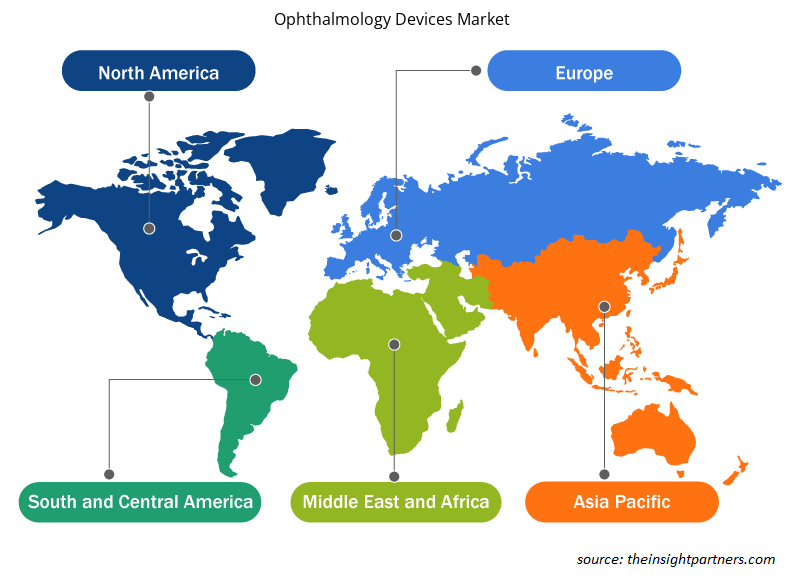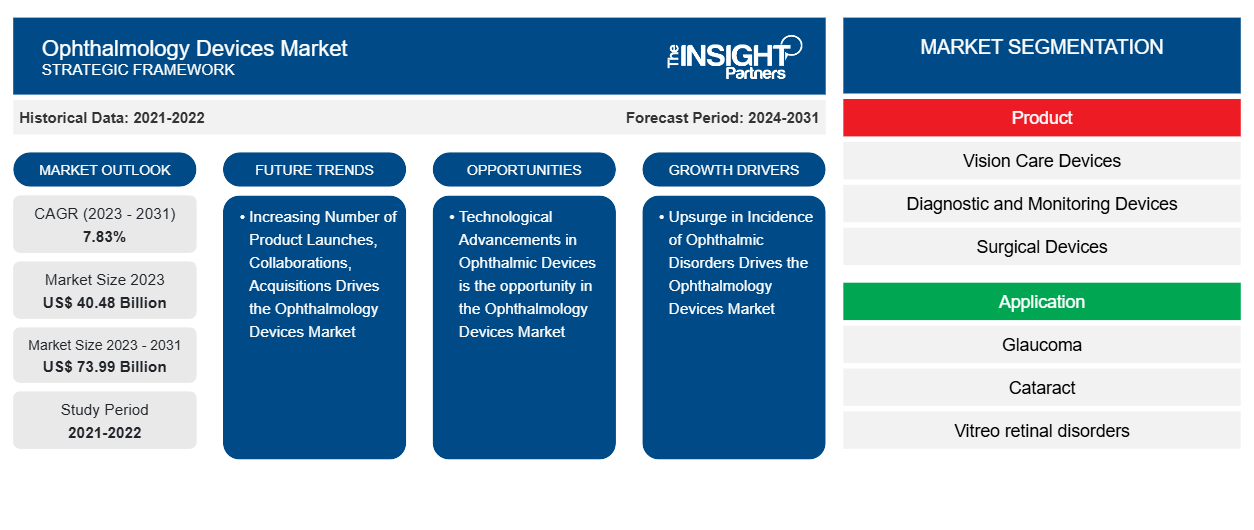眼科设备市场规模预计将从 2023 年的 404.8 亿美元增至 2031 年的 739.9 亿美元。预计 2023-2031 年市场复合年增长率将达到 7.83%。眼科疾病患病率的上升可能仍是眼科设备市场的主要趋势。
眼科设备市场分析
眼科设备用于手术、诊断和视力矫正。由于白内障、青光眼和其他视力相关问题的发病率很高,这些设备多年来变得越来越重要。此外,眼科设备市场的公司正在推出技术先进的隐形眼镜和眼镜片。由于医疗技术的进步、生活方式改变导致的眼部疾病患病率上升、慢性病发病率上升以及人口老龄化加剧,对眼科诊断和监测设备的需求正在上升。人工智能 (AI)、远程医疗和物联网 (IoT) 等先进技术在眼科筛查程序中发挥着关键作用,从而提高了运营效率、准确性、成本效益和眼科护理的可及性。
眼科设备市场概况
技术创新一直是任何生命科学学科的基础,包括眼科,因为现代设备是准确诊断和改善治疗的关键。药物、诊断设备、激光系统和手术技术的进步使得青光眼、白内障和黄斑变性以及干眼症的诊断得到改善。眼科疾病发病率的上升以及产品发布、收购和合作数量的增加等因素正在推动市场增长。此外,眼科设备的技术进步也为市场带来了机遇。然而,眼科手术的高成本是阻碍市场增长的主要因素。
定制此报告以满足您的需求
您可以免费定制任何报告,包括本报告的部分内容、国家级分析、Excel 数据包,以及为初创企业和大学提供优惠和折扣
- 获取此报告的关键市场趋势。这个免费样品将包括数据分析,从市场趋势到估计和预测。
眼科设备市场驱动因素和机遇
眼科设备的进步有利于市场增长
虚拟现实、3D 成像以及大数据和人工智能 (AI) 正用于眼科的数据分析。这些工具使得获得准确可靠的结果成为可能。AI 等工具正用于糖尿病视网膜病变的筛查、病变检测和疾病进展监测(例如,年龄相关性黄斑变性或黄斑水肿的进展)。然而,这些工具仍在开发中,因为正在评估它们在眼部病变诊断和预后应用中的适用性。微创手术,如 LASIK(即激光辅助原位角膜磨镶术)手术、飞秒激光手术、多波长糖尿病视网膜病变治疗和超声乳化术,可能会增加对眼科设备的需求,进而推动整个市场的增长。
远程医疗日益受到关注,为市场带来机遇
技术创新始终是任何生命科学学科的基础,包括眼科,因为现代设备是准确诊断和改善治疗的关键。药物、诊断设备、激光系统和手术技术的进步使得青光眼、白内障和黄斑变性以及干眼症的诊断得到改善。虚拟现实、3D 成像、大数据和人工智能 (AI) 正用于眼科的数据分析。这些工具使我们获得准确可靠的结果成为可能。人工智能等工具正用于筛查糖尿病视网膜病变、检测病变以及监测某些疾病(如老年性黄斑变性或黄斑水肿)的进展。然而,这些工具仍在开发中,目前正在评估它们在眼部病变诊断和预后应用中的适用性。微创手术,例如 LASIK(即激光原位角膜磨镶术)手术、飞秒激光手术、多波长糖尿病视网膜病变治疗和超声乳化白内障吸除术可能会增加对眼科设备的需求,进而推动整个市场的增长。
眼科设备市场报告细分分析
有助于得出眼科设备市场分析的关键部分是产品、视力保健设备、诊断和监测设备、手术设备、应用和最终用户。
- 根据产品,眼科设备市场分为视力保健设备、手术设备以及诊断和监测设备。视力保健设备部分在 2023 年占据了最大的市场份额。
- 根据应用,市场细分为青光眼、白内障、玻璃体视网膜疾病、难治性疾病等。青光眼领域在 2023 年占据了主要市场份额。
- 就最终用户而言,市场细分为医院和眼科诊所、学术和研究实验室等。2023 年,医院和眼科诊所占据了市场主导地位。
眼科设备市场份额按地区分析
眼科设备市场报告的地理范围主要分为五个区域:北美、亚太、欧洲、中东和非洲以及南美和中美。北美地区的市场增长可归因于青光眼和白内障等眼部疾病的患病率上升,以及北美国家主要制造商的存在。
眼科设备市场区域洞察
Insight Partners 的分析师已详尽解释了预测期内影响眼科设备市场的区域趋势和因素。本节还讨论了北美、欧洲、亚太地区、中东和非洲以及南美和中美洲的眼科设备市场细分和地理位置。

- 获取眼科设备市场的区域特定数据
眼科设备市场报告范围
| 报告属性 | 细节 |
|---|---|
| 2023 年的市场规模 | 404.8亿美元 |
| 2031 年市场规模 | 739.9 亿美元 |
| 全球复合年增长率(2023 - 2031) | 7.83% |
| 史料 | 2021-2022 |
| 预测期 | 2024-2031 |
| 涵盖的领域 | 按产品
|
| 覆盖地区和国家 | 北美
|
| 市场领导者和主要公司简介 |
|
市场参与者密度:了解其对商业动态的影响
眼科设备市场正在快速增长,这得益于终端用户需求的不断增长,而这些需求又源于消费者偏好的不断变化、技术进步以及对产品优势的认识不断提高等因素。随着需求的增加,企业正在扩大其产品范围,进行创新以满足消费者的需求,并利用新兴趋势,从而进一步推动市场增长。
市场参与者密度是指在特定市场或行业内运营的企业或公司的分布情况。它表明在给定市场空间中,相对于其规模或总市场价值,有多少竞争对手(市场参与者)存在。
在眼科设备市场运营的主要公司有:
- 强生视力保健公司
- 爱尔康公司
- 卡尔蔡司医疗技术公司
- 博士伦公司
- 依视路国际公司
免责声明:上面列出的公司没有按照任何特定顺序排列。

- 了解眼科设备市场顶级关键参与者概况
眼科设备市场新闻和最新发展
通过收集一手和二手研究后的定性和定量数据来评估眼科设备市场,其中包括重要的公司出版物、协会数据和数据库。以下是眼科设备市场的一些发展情况:
- Topcon Corporation 收购了总部位于意大利佛罗伦萨郊区的眼科设备制造商 VISIA Imaging Srl。通过此次收购,Topcon 打算进一步加强其定位良好的眼底成像设备组合——其中包括眼底照相机和光学相干断层扫描。此次收购增强了 Topcon 在前段设备和软件方面的开发和生产能力。此次收购还旨在加强其作为眼科诊断工具顶级生产商的地位。(来源:Topcon,新闻稿,2021 年 7 月)
- Iridex Corporation 与 Topcon Corporation 达成战略合作。Iridex Corporation 是一家知名的创新眼科激光医疗产品供应商,用于治疗青光眼和视网膜疾病。Iridex 收购了 Topcon 的 PASCAL 产品线,将其自己的 MicroPulse 技术与 Topcon 的 PASCAL 激光平台相结合。此次合作很可能有助于 Iridex 扩大其在视网膜扫描激光产品市场的份额。(来源:Iridex Corporation,通讯,2021 年 3 月)
眼科设备市场报告覆盖范围和交付成果
“眼科设备市场规模和预测(2021-2031)”报告对市场进行了详细的分析,涵盖以下领域:
- 范围内涵盖的所有主要细分市场的全球、区域和国家级眼科设备市场规模和预测
- 眼科设备市场趋势以及市场动态,如驱动因素、限制因素和关键机遇
- 详细的 PEST/波特五力分析和 SWOT 分析
- 眼科设备市场分析涵盖主要市场趋势、全球和区域框架、主要参与者、法规和最新市场发展
- 行业格局和竞争分析,涵盖市场集中度、热图分析、知名参与者以及眼科设备市场的最新发展
- 详细的公司简介
- 历史分析(2 年)、基准年、预测(7 年)及复合年增长率
- PEST 和 SWOT 分析
- 市场规模价值/数量 - 全球、区域、国家
- 行业和竞争格局
- Excel 数据集


- Machine Condition Monitoring Market
- Fertilizer Additives Market
- Hydrolyzed Collagen Market
- Clinical Trial Supplies Market
- Smart Water Metering Market
- Medical Second Opinion Market
- Electronic Shelf Label Market
- Quantitative Structure-Activity Relationship (QSAR) Market
- Medical and Research Grade Collagen Market
- USB Device Market

Report Coverage
Revenue forecast, Company Analysis, Industry landscape, Growth factors, and Trends

Segment Covered
This text is related
to segments covered.

Regional Scope
North America, Europe, Asia Pacific, Middle East & Africa, South & Central America

Country Scope
This text is related
to country scope.
常见问题
Factors such as the growing prevalence of ophthalmic disorders and the rising geriatric population prone to various eye disorders. However, the high cost of ophthalmic devices and lack of awareness related to these devices in developing countries hinder the ophthalmology devices market growth. Additionally, technological advancements are anticipated to bring new ophthalmology devices market trends in the coming years.
Ophthalmology devices are medical equipment used for vision correction, eye disease diagnosis, and surgical procedures. These devices include invasive devices such as implantable devices (intraocular lenses and glaucoma stents), and noninvasive diagnostic equipment and instruments. Key factors driving the market growth include the growing prevalence of ophthalmic disorders and the rising geriatric population prone to various eye disorders. However, the high cost of ophthalmic devices and lack of awareness related to these devices in developing countries hinder the ophthalmology devices market growth. Additionally, technological advancements are anticipated to bring new ophthalmology devices market trends in the coming years.
The ophthalmology devices market majorly consists of the players, including Johnson & Johnson Vision Care Inc., Alcon AG, Carl Zeiss Meditec, Bausch & Lomb Inc, Essilor International SAS, Nidek Co Ltd, Topcon Corp, Haag-Streit AG, Ziemer Ophthalmic Systems AG, and Hoya Corp.
The ophthalmology devices market was valued at US$ 40.48 billion in 2023.
The ophthalmology devices market is expected to be valued at US$ 73.99 billion in 2031.
Based on product, the ophthalmology devices market is divided into vision care devices, surgical devices, and diagnostic and monitoring devices. The vision care devices segment held the largest market share in 2023.
Based on application, the market is segmented into glaucoma, cataract, vitreoretinal disorder, refractory disorder, and others. The glaucoma segment held a major market share in 2023.
In terms of end user, the market is segmented into hospitals and eye clinics, academic and research laboratories, and others. The hospitals and eye clinics segment dominated the market in 2023.
Trends and growth analysis reports related to Life Sciences : READ MORE..
The List of Companies - Ophthalmology Devices Market
- Johnson & Johnson Vision Care Inc.
- Alcon AG
- Carl Zeiss Meditec
- Bausch & Lomb Inc
- Essilor International SAS
- Nidek Co Ltd
- Topcon Corp
- Haag-Streit AG
- Ziemer Ophthalmic Systems AG
- Hoya Corp.
The Insight Partners performs research in 4 major stages: Data Collection & Secondary Research, Primary Research, Data Analysis and Data Triangulation & Final Review.
- Data Collection and Secondary Research:
As a market research and consulting firm operating from a decade, we have published and advised several client across the globe. First step for any study will start with an assessment of currently available data and insights from existing reports. Further, historical and current market information is collected from Investor Presentations, Annual Reports, SEC Filings, etc., and other information related to company’s performance and market positioning are gathered from Paid Databases (Factiva, Hoovers, and Reuters) and various other publications available in public domain.
Several associations trade associates, technical forums, institutes, societies and organization are accessed to gain technical as well as market related insights through their publications such as research papers, blogs and press releases related to the studies are referred to get cues about the market. Further, white papers, journals, magazines, and other news articles published in last 3 years are scrutinized and analyzed to understand the current market trends.
- Primary Research:
The primarily interview analysis comprise of data obtained from industry participants interview and answers to survey questions gathered by in-house primary team.
For primary research, interviews are conducted with industry experts/CEOs/Marketing Managers/VPs/Subject Matter Experts from both demand and supply side to get a 360-degree view of the market. The primary team conducts several interviews based on the complexity of the markets to understand the various market trends and dynamics which makes research more credible and precise.
A typical research interview fulfils the following functions:
- Provides first-hand information on the market size, market trends, growth trends, competitive landscape, and outlook
- Validates and strengthens in-house secondary research findings
- Develops the analysis team’s expertise and market understanding
Primary research involves email interactions and telephone interviews for each market, category, segment, and sub-segment across geographies. The participants who typically take part in such a process include, but are not limited to:
- Industry participants: VPs, business development managers, market intelligence managers and national sales managers
- Outside experts: Valuation experts, research analysts and key opinion leaders specializing in the electronics and semiconductor industry.
Below is the breakup of our primary respondents by company, designation, and region:

Once we receive the confirmation from primary research sources or primary respondents, we finalize the base year market estimation and forecast the data as per the macroeconomic and microeconomic factors assessed during data collection.
- Data Analysis:
Once data is validated through both secondary as well as primary respondents, we finalize the market estimations by hypothesis formulation and factor analysis at regional and country level.
- Macro-Economic Factor Analysis:
We analyse macroeconomic indicators such the gross domestic product (GDP), increase in the demand for goods and services across industries, technological advancement, regional economic growth, governmental policies, the influence of COVID-19, PEST analysis, and other aspects. This analysis aids in setting benchmarks for various nations/regions and approximating market splits. Additionally, the general trend of the aforementioned components aid in determining the market's development possibilities.
- Country Level Data:
Various factors that are especially aligned to the country are taken into account to determine the market size for a certain area and country, including the presence of vendors, such as headquarters and offices, the country's GDP, demand patterns, and industry growth. To comprehend the market dynamics for the nation, a number of growth variables, inhibitors, application areas, and current market trends are researched. The aforementioned elements aid in determining the country's overall market's growth potential.
- Company Profile:
The “Table of Contents” is formulated by listing and analyzing more than 25 - 30 companies operating in the market ecosystem across geographies. However, we profile only 10 companies as a standard practice in our syndicate reports. These 10 companies comprise leading, emerging, and regional players. Nonetheless, our analysis is not restricted to the 10 listed companies, we also analyze other companies present in the market to develop a holistic view and understand the prevailing trends. The “Company Profiles” section in the report covers key facts, business description, products & services, financial information, SWOT analysis, and key developments. The financial information presented is extracted from the annual reports and official documents of the publicly listed companies. Upon collecting the information for the sections of respective companies, we verify them via various primary sources and then compile the data in respective company profiles. The company level information helps us in deriving the base number as well as in forecasting the market size.
- Developing Base Number:
Aggregation of sales statistics (2020-2022) and macro-economic factor, and other secondary and primary research insights are utilized to arrive at base number and related market shares for 2022. The data gaps are identified in this step and relevant market data is analyzed, collected from paid primary interviews or databases. On finalizing the base year market size, forecasts are developed on the basis of macro-economic, industry and market growth factors and company level analysis.
- Data Triangulation and Final Review:
The market findings and base year market size calculations are validated from supply as well as demand side. Demand side validations are based on macro-economic factor analysis and benchmarks for respective regions and countries. In case of supply side validations, revenues of major companies are estimated (in case not available) based on industry benchmark, approximate number of employees, product portfolio, and primary interviews revenues are gathered. Further revenue from target product/service segment is assessed to avoid overshooting of market statistics. In case of heavy deviations between supply and demand side values, all thes steps are repeated to achieve synchronization.
We follow an iterative model, wherein we share our research findings with Subject Matter Experts (SME’s) and Key Opinion Leaders (KOLs) until consensus view of the market is not formulated – this model negates any drastic deviation in the opinions of experts. Only validated and universally acceptable research findings are quoted in our reports.
We have important check points that we use to validate our research findings – which we call – data triangulation, where we validate the information, we generate from secondary sources with primary interviews and then we re-validate with our internal data bases and Subject matter experts. This comprehensive model enables us to deliver high quality, reliable data in shortest possible time.


 获取此报告的免费样本
获取此报告的免费样本